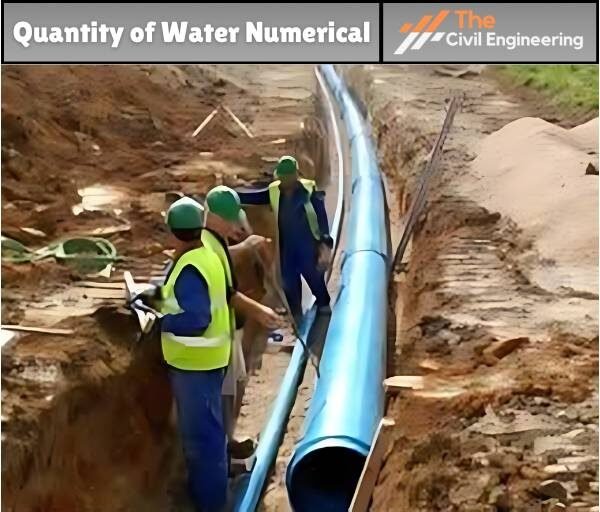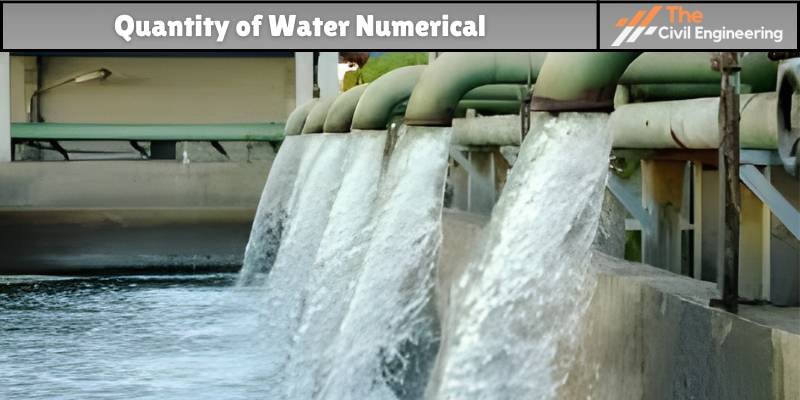In this article, we will discuss the quantity of water Numerical with formulas. numerical.
1. Formulas
i. Arithmetical Increase Method
| Pn = Po + nC |
Where,
Po = Number of the present population
Pn = Number of the population at time nth time unit
C = Average increase in population
ii. Geometrical Increase Method
| Pn = Po(1+r/100)n |
Where,
Po = Number of the present population
Pn = Number of the population at time nth time unit
r = Average of the % increase
iii. Incremental Increase Method
| Pn = Po + nc + ( n(n+1)i )/2 |
Where,
Po = Number of the present population
Pn = Number of the population at time nth time unit
i = Incremental increase per unit time
iv. Decreasing Rate Growth Method
| Pn = Po n∏j=1 [1+(Io-jd)/100] |
where,
Po = Number of the present population
Pn = Number of the population at time nth time unit
Io= % increase in population in last known yr % time unit
j = Average decrease in % increment % time unit

2. Quantity of Water Numerical
Determine the population of the town in the year 2026 by a) Arithmetical, b) Geometrical, c) Incremental increase and d) Decreased rate of growth method.
| Year AD | 1961 | 1971 | 1981 | 1991 | 2001 | 2011 |
| Population | 18000 | 27000 | 38000 | 51000 | 66000 | 83000 |
Solution:
n = (2026-2011)/10 = 1.5
Present or last known population (Po)= 83000
| Year AD | Population | Increase in population | % increase in population | Incremental increase | Decrease in % increase |
| 1961 | 18000 | – | – | – | – |
| 1971 | 27000 | 9000 | 50 | – | – |
| 1981 | 38000 | 11000 | 40.74 | 2000 | 9.26 |
| 1991 | 51000 | 13000 | 34.21 | 2000 | 6.53 |
| 2001 | 66000 | 15000 | 29.41 | 2000 | 4.80 |
| 2011 | 83000 | 17000 | 25.75 | 2000 | 3.66 |
| Total | 65000/5 | 180.11/5 | 8000/4 | 24.25/4 | |
| Average | C= 13000 | r= 36.022 | i=+2000 | d= +6.0625 | |
i) Arithmetic Method:
Pn = Po +nC
P1.5 = 83,000 + 1.5 x 13000
P1.5 = 102500 nos
ii) Geometric Method:
Pn = Po(1+r/100)n
P1.5 = 83000(1+36.022/100)1.5
P1.5 = 1,31,672 nos
iii) Incremental Method
Pn = Po + nc + ( n(n+1)i )/2
P1.5 = 83,000+1.5 x 13000 +1.5 x 2000 x (1.5+1)/2
P1.5 = 1,06,250 nos
iv) Decreased rate growth method
Pn = Po n∏j=1 [1+(Io-jd)/100]
P1.5 = 83000 (1+25.75-6.0625/100)(1+25.75-1.5 x 6.0625/100)
P1.5 = 1,15,887 nos
2. Estimate the population of a town for the design year 2031 AD by any three methods and calculate the design quantity of water in lit/day.
The census data are as follows:
| Year AD | 1971 | 1981 | 1991 | 2001 |
| Population | 40000 | 45000 | 55000 | 62000 |
Also, consider fire demand and losses and wastage.
Solution:
n = (2031-2001)/10 = 3
Present or last known population (Po)= 62000
| Year AD | Population | Increase in population | %increase in population | Incremental increase |
| 1971 | 40,000 | – | – | – |
| 1981 | 45,000 | 5,000 | 12.50 | – |
| 1991 | 55,000 | 10,000 | 22.22 | 5000 |
| 2001 | 62,000 | 7,000 | 12.73 | -3000 |
| Total | 22000/3 | 47.45/3 | 2000/2 | |
| Average | C=7333 | r=15.82 | i=+1000 | |
i) Arithmetic Method:
Pn = Po +nC
P3 = 62,000 + 3 x 7333
P3 =83999 nos
ii) Geometric Method:
Pn = Po(1+r/100)n
P3 = 62000(1+15.822/100)3
P3 = 96326 nos
iii) Incremental Method
Pn = Po + nc + ( n(n+1)i )/2
P3 = 62,000 + 3 x 7333+ 3((3+1)/2) x 1000
P3 = 89,999 nos
Taking design year (2031 AD) population as forecasted by geometrical method = 96326 nos
Assume per capita water demand for the town as 112 lpcd.
a). Domestic demand for town = Population x per capita demand
= 96326 x 112
= 10788512 lit/day
b). Assume 1 lpcd of water for fire fighting
= 96326 x 1 lpcd
= 96326 lit/day
c) Assume losses demand
Therefore, Total water demand
TD = Domestic demand + Fire demand + Losses demand.
TD = 10788512+96326+0.15TD
0.85 TD = 10884838
Total water demand= 12805692 lit/day
3. In rural villages, the survey is carried out in the year 2072 BS and the following data is obtained.
Solution,
Population = 5320 nos
Annual population growth rate = 1.7%
No. of cows = 4030 nos
No. of goats = 1520 nos
No. of chickens = 5500 nos
No. of students = 200 boarders & 1020 day scholars
No. of VDC offices = 5
No. of Tea shops = 3
If the base year is taken as 2075 BS and the design period is 20 years. Calculate the total water demand of the village for the service year.
Solution:
Survey year= 2072,
Total water demand in design year(2095)=?
For design year, n= base period + design peroid
=3+20
=23 years
Design year population by geometrical forecasting method;
Pn = Po(1+r/100)n
P23 = 5320 (1+1.7/100)23
P23 = 7840 nos
Calculation of water demand;
a. Domestic demand= 7840 @ 45 lpcd = 352800 lit/day
b. Livestock demand
For cows = 4030 nos @ 45 lit/animal/day = 181350 lit/day
For goats = 1520 nos @ 20 lit/goat/day = 30400 lit/day
For chickens = 5500 nos @ 0.2 lit/bird/day =1100 lit/day
Total livestock demand= 212850 lit/day
Comparing livestock demand with 20% of domestic demand;
20% of domestic demand = 70560 lit/day
Total livestock demand is greater than 20% of domestic demand so take livestock demand = 70560 lit/day
c. Commercial and Institutional demand
For day scholars students= 1020 nos @ 10 lpcd = 10200 lit/day
For boarders= 200nos @ 65 lpcd = 13000 lit/day
For VDC office = 5 @ 500 lit/office/day= 2500 lit/day
For Tea Sop = 3 @ 500 lit/teastall/day= 1500 lit/day
Total commercial & institutional demand= 27200 lit/day
Total water demand for design year= DD+LD+ID
= 352800+70560+27200
=4,50,560 lit/day
| Read Also: How To Calculate Area of Land Or Plots Area That Are Irregular In Shape |
4. Safe yield of a proposed spring is 5 lps and per capita, water demand is 65 lpcd. calculate the current population that can be taken under the scheme if design period is 20 years and the population growth rate is 1.7% per annum
Solution:
Safe yield of proposed spring (Q) = 5 x 60 x 60 x24 = 432000 lit/day
Per capita demand = Q/P20
P20 = 432000/65 = 6647 nos
Let Po be the current population for the scheme;
P20 for the scheme = P0(1+1.7/100)20 = 4744 nos
The Current Population (Po) that can take under the scheme is 4744 nos.
| Read Also: Correction of Length & Area Due To Incorrect Scale or Chain | 7 Numericals |
5. In a rural village, the survey is carried out in the year 2072 BS and the following data is obtained:
Population = 5000 nos
Annual population growth rate = 1.5 %
Annual growth rate for students = 1%
No. of cows = 50 nos
No. of goats = 250 nos
No. of chickens = 2000 nos
No. of schools 2 with overall 350-day scholars students
No of VDC offices= 2
No. of Tea shops = 3
If the base year is taken as 2075 BS and.the design period is 20 calculate the total water demand of the village for the service year.
Solution,
Survey year = 2072,
Total water demand in Design year (2095) = ?
For design year, n = Base period + design period = 3+20
= 23 years
Design year population by geometrical forecasting method;
Pn = Po(1+r/100)n
P23= 5000(1+1.5/100)23
=7042 nos. 1
Similarly, Students population (P23) = 350 (1+1/100)23
= 440 nos,
Calculation of water demand;
a. Domestic demand = 7042 @ 45 Iped = 316890 lit/day
b. Livestock demand
For Cows = 50 nos @ 45 lit/animal/day = 2250 lit/day
For goats = 250 nos @ 20 litigoat/day 5000 lit/day
For chickens 2000 nos @ 0.20 lit/bird/day = 400 lit/day
Total livestock demand = 7650 lit/day
Comparing livestock demand with 20% of domestic demand;
20% of domestic demand = 633 78 lit/day.
Total livestock demand is less than 20% of domestic demand so livestock demand = 7650 lit/day
c. Commercial and Institutional demand For day scholars students = 440 nos @ 10 Ipcd = 4400 lit/day
For VDC office 2 a 500 lit/office/day 1000 lit/day
For Tea Sop = 3 @ 500 lit/teastall/day= 1500 lit/day
Total commercial & institutional demand= 6900 lit/day
Total water demand for design year= DD+LD+ID
= 31689000+7650+6900
= 331440 lit/day
| Read Also: Closed Traverse | Numerical of Closed Traverse | Plotting of Closed Traverse |


